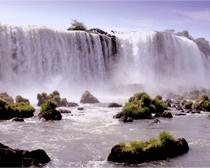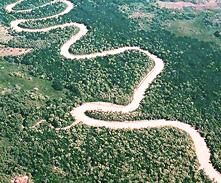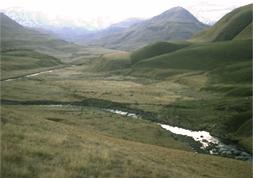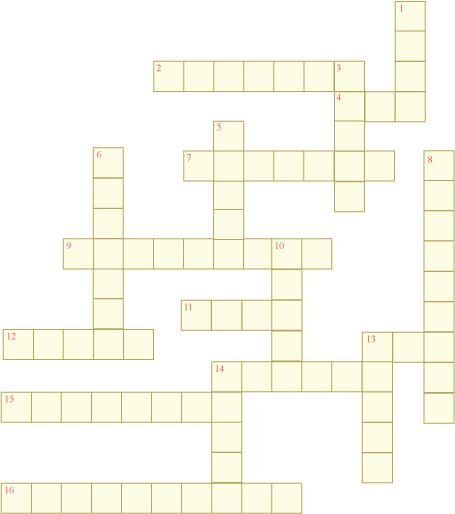Sponsor Area
Our Changing Earth
Answer the following questions.
(i) Why do the plates move?
(ii) What are exogenic and endogenic forces?
(iii) What is erosion?
(iv) How are flood plains formed?
(v) What are sand dunes?
(vi) How are beaches formed?
(vii) What are ox-bow lakes?
(i) The Lithospheric plates move around because of the movement of the molten magma inside the Earth.
(ii) Earth’s movements are divided on the basis of the forces which cause them. The ones that work on the Earth’s surface are called exogenic forces while the ones that work in the Earth’s interior are called endogenic forces. The erosional and depositional activities of wind and water are examples of exogenic forces. Earthquakes and volcanoes are examples of endogenic forces.
(iii) Erosion is the weathering or wearing away of the landscape by different agents like wind, water and ice.
(iv) During its course through a plain, a river sometimes overflows its banks. This leads to the flooding of the neighbouring areas. As it floods, the river water deposits layers of fine soil and sediments on its banks. This leads to the formation of a flat, fertile flood plain.
(v) In deserts, when wind blows, it lifts and transports sand from one place to another. When it stops blowing, the sand particles fall and get deposited in low hill-like structures called sand dunes.
(vi) The erosional and depositional activities of the sea waves give rise to different coastal landforms. A beach is one such coastal landform. It is formed when the sea waves deposit sediments along the sea shore.
(vii) An ox-bow lake is a crescent-shaped lake formed by a meandering river. During its journey through a plain, a river twists and turns to form meanders. Erosion and deposition occur constantly along the sides of a meander, thereby causing the ends of its loop to come closer and closer. In due course of time, the meander loop cuts off from the river and forms a cut-off, crescent-shaped ox-bow lake.
Some More Questions From Our Changing Earth Chapter
Tick the correct answer.
(i) Which is not an erosional feature of sea waves?
(a) Cliff
(b) Beach
(c) Sea cave
(ii) The depositional feature of a glacier is
(a) Flood plain
(b) Beach
(c) Moraine
(iii) Which is caused by the sudden movements of the Earth?
(a) Volcano
(b) Folding
(c) Flood plain
(iv) Mushroom rocks are found in
(a) Deserts
(b) River valleys
(c) Glaciers
(v) Ox-bow lakes are found in
(a) Glaciers
(b) River valleys
(c) Deserts
(a) Cliff
(b) Beach
(c) Sea cave
(a) Flood plain
(b) Beach
(c) Moraine
(a) Volcano
(b) Folding
(c) Flood plain
(a) Deserts
(b) River valleys
(c) Glaciers
(a) Glaciers
(b) River valleys
(c) Deserts
Match the following.
(i) Glacier
(a) Sea shore
(ii) Meanders
(b) Mushroom rock
(iii) Beach
(c) River of ice
(iv) Sand dunes
(d) Rivers
(v) Waterfall
(e) Vibrations of Earth
(vi) Earthquake
(f) Sea cliff
–
(g) Hard bed rock
–
(h) Deserts
(i) Glacier
(a) Sea shore
(ii) Meanders
(b) Mushroom rock
(iii) Beach
(c) River of ice
(iv) Sand dunes
(d) Rivers
(v) Waterfall
(e) Vibrations of Earth
(vi) Earthquake
(f) Sea cliff
–
(g) Hard bed rock
–
(h) Deserts
Give reasons.
(i) Some rocks have a shape of a mushroom.
(ii) Flood plains are very fertile.
(iii) Sea caves are turned into stacks.
(iv) Buildings collapse due to earthquakes.
Activity.
Observe the photographs given below. These are various features made by a river. Identify them and also tell whether they are erosional or depositional or landforms formed by both.
Photograph
Name of the Feature
Type
[Erosional or Depositional or Both]

–
–

–
–

–
–
Photograph
Name of the Feature
Type
[Erosional or Depositional or Both]

–
–

–
–

–
–
For fun.
Solve the crossword puzzle with the help of given clues.

Across
Down
2. Loop like the bend of a river
1. Rise and fall of water caused by frictionof wind on water surface
4. Solid form of water
3. Flow of water in a channel
7. Moving mass of ice
5. Steep perpendicular face of a rock alongsea coast
9. Sudden descent of water in the bed of a river
6. Debris of boulder and coarse materialcarried by glacier
11. Natural cavity on weak rocks formed by action of waves
8. Crescent-shaped lake formed by a meandering river
12. Embankment on a river that keeps itin its channel
10. Fine sand deposited by the action of the wind
13. Large body of sea water
13. Isolated mass of rising steep rock near acoastline
14. Dry area where sand dunes are found
14. Alluvial tracts of land formed by river deposits at mouth of the river
15. Small hill of sand caused by the action of the wind
–
16. Flat plain formed by river deposits during time of flood
–

Across
Down
2. Loop like the bend of a river
1. Rise and fall of water caused by frictionof wind on water surface
4. Solid form of water
3. Flow of water in a channel
7. Moving mass of ice
5. Steep perpendicular face of a rock alongsea coast
9. Sudden descent of water in the bed of a river
6. Debris of boulder and coarse materialcarried by glacier
11. Natural cavity on weak rocks formed by action of waves
8. Crescent-shaped lake formed by a meandering river
12. Embankment on a river that keeps itin its channel
10. Fine sand deposited by the action of the wind
13. Large body of sea water
13. Isolated mass of rising steep rock near acoastline
14. Dry area where sand dunes are found
14. Alluvial tracts of land formed by river deposits at mouth of the river
15. Small hill of sand caused by the action of the wind
–
16. Flat plain formed by river deposits during time of flood
–
Sponsor Area
Mock Test Series
Mock Test Series





